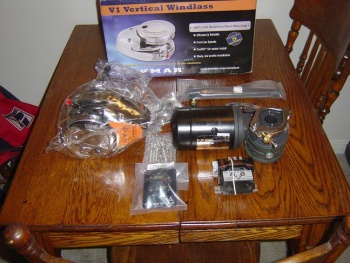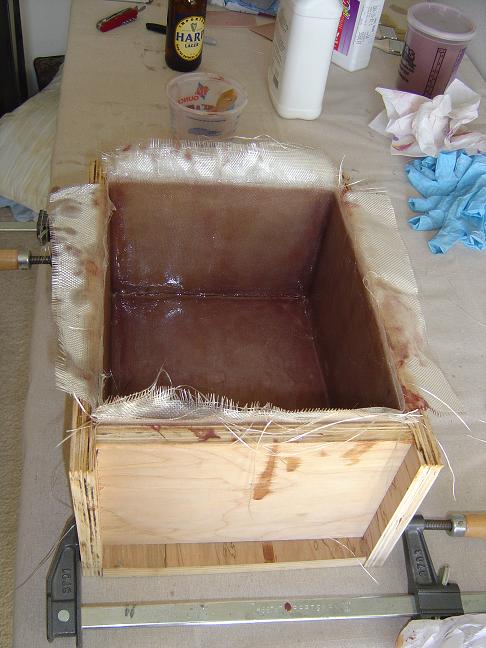Difference between revisions of "Lewmar V-1 Vertical Windlass Installation on 1990 Catalina 34"
| Line 51: | Line 51: | ||
When the epoxy resin was still “green” (not quite hard), I used a sharp knife to rough trim the top. Once the resin had setup, I trimmed the edges with a table saw. I used the table saw to also cut a 1/4" groove (1/4" deep) in all four edges to remove the plywood. I filled the groove using epoxy resin and colloidal silica. To attach the top to the box I used four 1/4" x 2" stainless steel flat head machine screws (holes were countersunk) and 2 layers of 8 oz. fiberglass cloth (saturated in epoxy resin) between the top and the box. Top was screwed down tight to the box and the resin was allowed to cure. Using the template that came with the windlass, I drilled five 3/8” holes for the mounting bolts and used a 3” hole saw to cut the two holes for the rode and the motor shaft. I also used a 6” hole saw to cut the hole for the windlass motor. | When the epoxy resin was still “green” (not quite hard), I used a sharp knife to rough trim the top. Once the resin had setup, I trimmed the edges with a table saw. I used the table saw to also cut a 1/4" groove (1/4" deep) in all four edges to remove the plywood. I filled the groove using epoxy resin and colloidal silica. To attach the top to the box I used four 1/4" x 2" stainless steel flat head machine screws (holes were countersunk) and 2 layers of 8 oz. fiberglass cloth (saturated in epoxy resin) between the top and the box. Top was screwed down tight to the box and the resin was allowed to cure. Using the template that came with the windlass, I drilled five 3/8” holes for the mounting bolts and used a 3” hole saw to cut the two holes for the rode and the motor shaft. I also used a 6” hole saw to cut the hole for the windlass motor. | ||
| + | |||
| + | {| | ||
| + | ||[[image:Windlass_Project_Box_4.JPG|thumb|350px|left|Attaching Top]] | ||
| + | |Note: I managed to burn up my Sears ½” drill cutting all three holes. The laid up box is very HARD, so don’t skimp on the quality of the hole saw like I did! | ||
| + | |} | ||
| + | |||
| + | {| | ||
| + | ||[[image:Windlass_Project_Flange.JPG|thumb|350px|left|Flange]] | ||
| + | |FLANGE | ||
| + | |||
| + | The flange that was added to the port side was laid up in the same way using the two side pieces from the original box mold, nailed together to form an "L". The fiberglass was again laid up alternating layers of 8 oz. fiberglass cloth and biaxial cloth (medium weight). The finished result ended up being about 5/16" thick. | ||
| + | |} | ||
| + | |||
| + | I sanded the two surfaces that would be mated together with 50 grit sandpaper. I drilled four 1/4" holes (2 on each side) for two pair of stainless steel 1/4" x 1" flat head machine screws and nuts. I used two pieces of 8 oz. cloth (saturated in epoxy resin) between the box and the flange. Once, I tightened down the screws, I cleaned up the resin that was forced out. My original plan was to remove these screws after the resin had setup, but with the resin getting into the threads, I decided that I would just leave the screws in place. | ||
article in progress - 7/24/09 | article in progress - 7/24/09 | ||
Revision as of 14:49, 25 July 2009
Vertical Windlass Installation Guide
By Rick Johnson Godspeed #1110 1990
After 4 years of assigning unsuspecting newbie crew members the task of hauling up the anchor, I was beginning to run out of victims. Since the captain of S/V Godspeed (1990 Catalina 34 #1110) is just over a ½ century in age and with a 35lbs CQR anchor, I decide that installing a windlass might be a valuable improvement.
| When I noticed that the Lewmar V-1 windlass was being discontinued and the discounted price was as low as $420 for a new windlass, I decided it was time to pry open my wallet. |
The original concept was to construct a fiberglass box that would fit into the recessed portion of the aft bulkhead of the anchor well (see photo below). This box would allow me to mount a vertical windlass without cutting holes in the deck or the anchor well hatch. I did realize that a hole would need to be cut in the bulkhead for the windlass motor, but felt it might be similar to how the factory installed windlass is mounted. Since the windlass would be entirely within the anchor well and the hatch was still intact, I felt the windlass would be protected from the elements. The other consideration was that I would not have issues with the windlass snagging jib sheets or other lines. It all sounded good to me in the planning stages.
| Note: The picture is not my anchor well. My C34 never had a windlass installed.
One issue that became apparent right away was that if the top of the fiberglass box was the same height as the surrounding fiberglass structure the top of the windlass would block the anchor well hatch from closing. The first modification was to drop the top of the fiberglass box to provide clearance. The finished dimensions were calculated to be 9" wide x 6" deep x 11" tall. Since I had the "finished” dimensions, I decided to construct a female mold and work from that. For construction I decided that the box should be alternating layers of fiberglass cloth and fiberglass bi-axel cloth. To save a little money, I used MAS epoxy resin which costs slightly less than West Systems. One “failure to notice” at this point was that the recess in the anchor well is not by any means “square”! |
| BOX
I used 3/4" birch plywood from Home Depot for the mold. The sections were clamped together and the inside coated with a heavy layer of Johnson's paste wax as a release agent. |
| I alternated layers using 8 oz fiberglass cloth and the biaxial cloth (medium weight). |
After every two layers of cloth I would add a layer of 6" wide fiberglass cloth tape around the parameter of the box to build up more strength in the sides of the box. I don't remember the total numbers of layers but it was probably around twelve layers. The box is a little over 5/16" thick. Probably more like 3/8" on the face.
| Note: Yes, Harp beer is a requirement if you want this project done right! |
| TOP
The top piece was constructed using 1/4" marine plywood cut to 11”x9”. I laid up alternating layers of 8 oz. fiberglass cloth and biaxial cloth (medium weight) on both sides until the whole top was 3/4" thick. |
When the epoxy resin was still “green” (not quite hard), I used a sharp knife to rough trim the top. Once the resin had setup, I trimmed the edges with a table saw. I used the table saw to also cut a 1/4" groove (1/4" deep) in all four edges to remove the plywood. I filled the groove using epoxy resin and colloidal silica. To attach the top to the box I used four 1/4" x 2" stainless steel flat head machine screws (holes were countersunk) and 2 layers of 8 oz. fiberglass cloth (saturated in epoxy resin) between the top and the box. Top was screwed down tight to the box and the resin was allowed to cure. Using the template that came with the windlass, I drilled five 3/8” holes for the mounting bolts and used a 3” hole saw to cut the two holes for the rode and the motor shaft. I also used a 6” hole saw to cut the hole for the windlass motor.
| Note: I managed to burn up my Sears ½” drill cutting all three holes. The laid up box is very HARD, so don’t skimp on the quality of the hole saw like I did! |
| FLANGE
The flange that was added to the port side was laid up in the same way using the two side pieces from the original box mold, nailed together to form an "L". The fiberglass was again laid up alternating layers of 8 oz. fiberglass cloth and biaxial cloth (medium weight). The finished result ended up being about 5/16" thick. |
I sanded the two surfaces that would be mated together with 50 grit sandpaper. I drilled four 1/4" holes (2 on each side) for two pair of stainless steel 1/4" x 1" flat head machine screws and nuts. I used two pieces of 8 oz. cloth (saturated in epoxy resin) between the box and the flange. Once, I tightened down the screws, I cleaned up the resin that was forced out. My original plan was to remove these screws after the resin had setup, but with the resin getting into the threads, I decided that I would just leave the screws in place.
article in progress - 7/24/09




